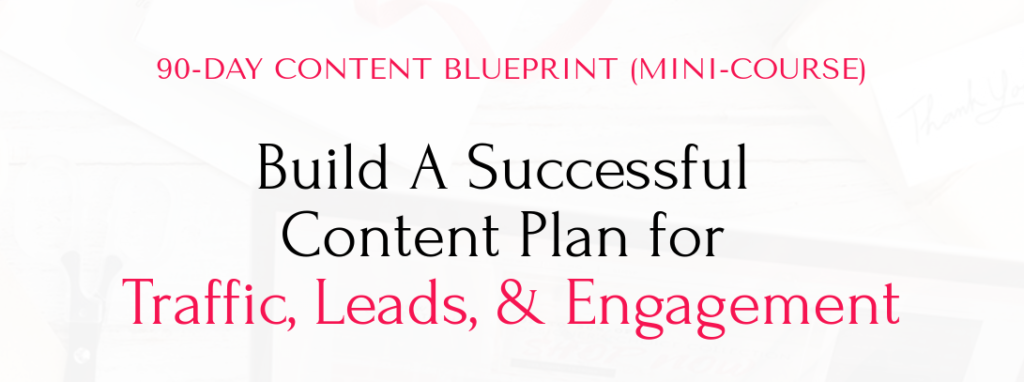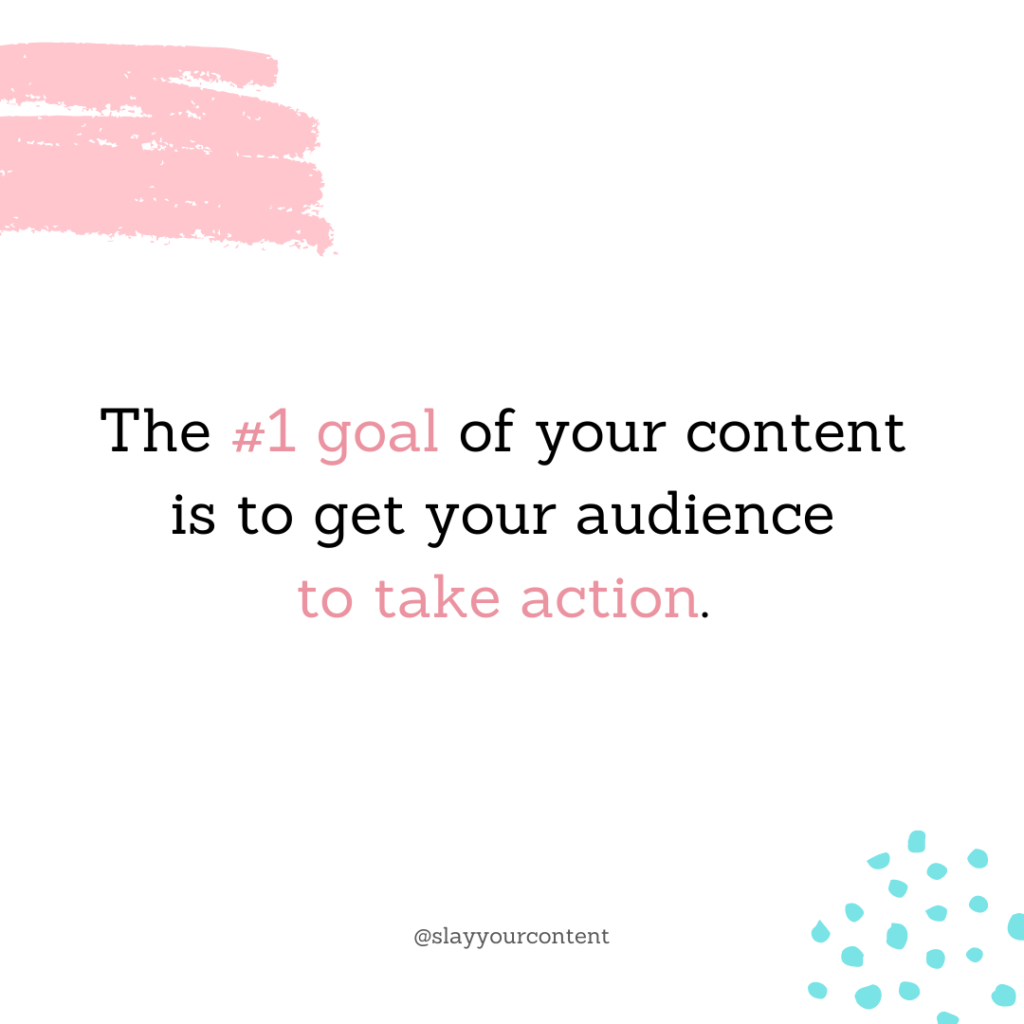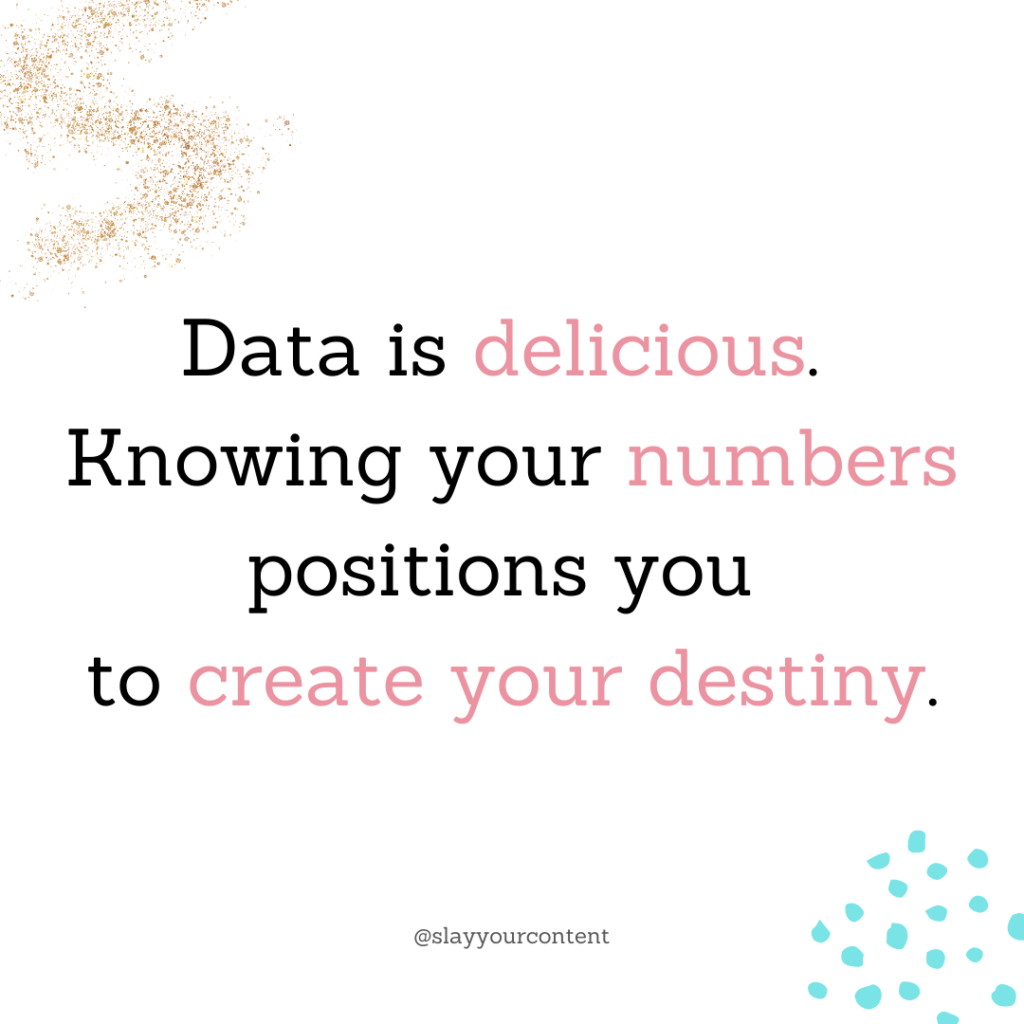You’re probably aware that you should have a content strategy for your business.
But, what is a content strategy? And what exactly goes into creating one?
Such excellent questions for the professional woman turned entrepreneur who wants to make moves in their online marketing yet feels all over the place with their content.
The good news is, this article will give you greater clarity into creating a content strategy and why its key to implement for your business.
In fact, you’ll learn more about
Let’s dive in, sis 👏🏽
What Is a Content Strategy
Here’s a true definition of content strategy borrowed from (and credited to) HubSpot:
In other words, the intention behind creating content is to move you closer to your business goals. Thus, it’s important to be clear on what your business objectives are so your content strategy is in alignment.
We’ll get to that in a bit.
Additionally, I love the second part of this definition because it encourages us to think critically about having content that supports each level of the buyer’s journey and beyond.
Stages of the Funnel
So, I touch on this in an article that discusses content that drives sales, yet, to bring it to life here a bit, the three stages of the buyer’s journey include the top of the funnel, middle of the funnel, and bottom of the funnel.
Top of the funnel is the awareness stage where people are seeking answers, insights, opinions, and education. Blog posts, social media, and eBooks are perfect for this phase.
The middle of the funnel content is the evaluation stage. People are actively researching on whether your brand is the ideal solution for them. Social media also works well here in addition to email marketing and comparison guides–how you compare to similar brands, products or services.
Finally, the bottom of the funnel is known as the decision stage. They’re ready to buy! Our job is to make it easy for them to do so. Discount codes/coupons, free trials and consultations are ideal content pieces.
Having content that supports each of these stages increases our opportunity of converting followers into customers, and customers into brand advocates.
That’s what I’m talking about!

Why Is Content Strategy Important to Your Business?
A content strategy keeps us intentional, makes us impactful, and gets us to the money.
It increases our chances of consistently showing up in our business. We have a plan, and our job is to execute.
No more willy-nillying it or randomly posting.
Our content aligns with the end goal; meaning, more sales, more people knowing about our brands, more email subscribers…
Whatever that looks like for you, having a content strategy will get you there.
Keep in mind the reason why you’re doing what you’re doing. You have so much wisdom, knowledge, and expertise to share with the 🌎, and there are people waiting to be transformed by your message.
A content strategy gives you the power to influence, move mountains, and change people’s lives. The more people know about us, the more we can impact.
I had a conversation with one of my mentors, Nicole Cooper, and she said something so powerful:
It’s not that there aren’t talented people out there. People just don’t know that you exist.
How many of us are hiding in the shadows? Or wishing we had more people that knew about our brand, product, or service?
A content strategy well-executed gets you exactly that: visibility, impact, profits.
Cheers to content strategy🥂!
What Goes Into Creating a Content Strategy?
So, what does a content strategy look like? What are all the pieces and how can I begin to implement it in my business?
Great questions!
The remaining sections highlight what makes a good content strategy, the best times of the year to do your content strategy, and your next steps to getting it done.
In fact, I wrote an entire book on how to develop your own content strategy that gets more people to your website, generates leads, and gets more sales.

Now, this post gives you a strong overview. The book takes you into a deeper dive with actionable questions to get it done and supporting videos (coming end of May 2022).
Ah, I’ll take the book, with the videos, please!
Here are the seven steps to a content strategy:
#1 Be Clear On Your Goals
As we pointed out earlier, your content should get you to your business goals. It’s important to know what they are so you know what you’re aiming for.
This is the prerequisite that many of us miss. Oftentimes, we want to get straight to making the money but we don’t have clear goals written down or set.
Here are some questions to ask yourself:
- What do I want to achieve as an entrepreneur? What’s my why?
- What do I want to achieve this quarter? More followers, more customers, more subscribers? Put a number on it!
- Who am I targeting? Who exactly do I want to impact?
- What is my revenue goal this quarter?
Being clear on…
- Your why–the reason you’re an entrepreneur, what’s going to drive you,
- The who–the group of people I’m aiming to impact), and
- Your what–the business goals I’m shooting for this quarter)…
Is the absolute first step to a strong content strategy.

#2 Establish Your Process for Generating Topic Ideas
Okay, so what are you going to talk about? How do you find ideas for topics to write on?
Having a process or a system that helps you generate topic ideas consistently is vital.
Here’s the secret to success when it comes to content creation:
Ensuring your topics stem from your product/service, and your offers.
This way, you’re priming your audience for your offer. Whenever you do a promotion, it will make sense to your people because you’ve already been preparing them for it.
There are so many ways to generate topic ideas including:
- Having a brain dumping session
- Asking your customers what their biggest challenges are in your industry
- Share a survey on social
Need some resources? Here are several that will help you generate endless topic ideas:
- The 7 Best Blog Post Ideas Your People Will Love, Like, and Trust
- How to Use Google Search for Endless Free Content Ideas {Video}
- Do You Feel Like You’re All Over the Place with Your Content?
Finally, you can join my email list. Every month I drop content ideas you can use for the following month to help flesh out your content strategy.
Don’t miss out on these goods, sis!
#3 Plan Your Content
Armed with your topics, the next step is organizing them into a 3-month calendar so you know what you’re creating over the next 90 days.
The best tool you can use is an editorial calendar to help you organize these ideas. Here’s a free one you can use below (it’s the same one I use btw):
Now, I like to organize my topic ideas into themes; each month has the main topic idea (The Theme) and every content piece created that month will come from that theme.
For example, let’s say you have an e-commerce website selling jewelry and your value prop is you show corporate women how to practice self-care and confidently express themselves in the boardroom and beyond.
Ideas for monthly themes could be Preparing for the Boardroom, Self-Care that Improves Careers, Looks that Radiate Confidence.
Then, you break your theme into four core topics. You’ll create either a blog post, podcast episode, or YouTube training video for each of those core topics. From those content pieces, you’ll get your social media content, quotes, etc. to supply you for the week.
Each week, you can sprinkle designer pieces that align with the topic of the week. 🙂

I have a mini-course that shows you how to do exactly this so that your themes and topics align with your actual products.
#4 Create Your Content

You’ve got the plan, now it’s time to make it happen! Let’s create.
There are different ways to get your content created: Batch it, Work in Chunks, or Source it Out. The good news is, you can choose one or a mix.
#1 Batch Your Content
This method means you’re creating 30 days of content over 1-3 days, getting it all done in one sitting. This strategy is working smarter not harder because you’re already in a writing/creation flow.
You’re also eliminating the stress of having to create your content throughout month. You get to focus on other parts of your business while your content is running on autopilot throughout the month.
Taking the last weekend of the month to create for the following month is a great idea…one that sista girl here is employing!
#2 Break it Up
If it’s hard for you to use the batching method, then divide your content creation tasks into smaller chunks by working 30-90mins daily. The Pomodoro Technique is an excellent productivity hack to staying focused and conquering assignments.
#3 Source it Out
I’m also a big fan of getting stuff off your plate by hiring expert content creators to get it done for you. They already love what they do and this frees up your time to focus on selling and doing what you do best.

#5 Promote Your Content
The 80/20 Rule of Content Marketing: You should spend 20% of your time creating content and 80% of your time promoting it.
It’s simply not enough to create a blog, podcast, or video training and then hope you get massive amounts of traffic drawn to it.
Nope. You’ve gotta put some elbow grease in it.
A promotional strategy ensures we’re intentionally driving eyeballs to our piece.
It can consist of a mix of organic and paid tactics (best results).
Here’s an example you can copy and swipe:
- Share with your email list on Monday
- Create 5-10 pins to share on Pinterest using Tailwind
- Share link with your Facebook group highlighting 3 reasons why they should read it
- Use Pinterest Ads to promote pin
- Publish post on Medium (wait 21 days after its been on your site)
- DM three FB friends on why the piece will be useful for them based on previous conversations you’ve had with them
- Tweet 7-10 quotes from your piece. Share those tweets on FB/IG
Have a promotional checklist you follow every time you drop your blog post, podcast episode, or video tutorial.
#6 Test, Test, Test!
With all this activity going on, it’s important to know that what we’re doing is actually working and that it’s connecting with our audience.
So we must test and analyze our marketing. Doing so sets us up for success to continue to perfect and do more of what’s working…and tweak/make adjustments to the things that are not.

Google Analytics is a good place to start in discovering which topics are landing with your people. Every tool that you use (i.e. email marketing, social media automation, etc.) has analytics reporting.
These tools are your best friends.
Get familiar with them and begin tracking. It’s how you play to win!
#7 Repurpose and Reuse
With all this content we’re creating, surely there are opportunities for multiple uses.
This is where content repurposing comes in. You see, by simply converting or changing the original piece into a different format, we’re giving ourselves a leg-up in our content marketing.
That’s what having a content strategy is all about. I can take this exact blog post that you’re reading and do the following:
- Host a webinar or video tutorial on the 7 Steps to Creating a Content Strategy
- Use each subheading for seven Facebook live video topics
- Convert this into a PDF as a downloadable lead magnet
Content repurposing allows you to expand your marketing and reach more people, giving them different ways to consume your content.
On another note, I can also republish this content on syndication sites such as Business2Community, Medium (as mentioned above), or LinkedIn.
It’s why I love blogging because one blog post can work in many ways to my advantage…and to also my audiences.
The Best Time to Do Your Content Strategy

I suggest doing your content strategy for a 90-day period. Having your content strategy ready before the quarter begins is the best.
Meaning, that at the latest, you should be creating your content strategy for the next quarter during the last two weeks of the current quarter.
However, I encourage you not to wait.
Go ahead and create your strategy now for the next 30-60 days, depending on when you’re reading this. Then, you can start a fresh strategy for the next quarter.
Make sense?
How to Get Started with Your Content Strategy
Need help with your 90-day content calendar?
If you’re ready to go deeper and get tactical, I got you covered!
Based on the level of support you need, here are some great resources in my arsenal:
Option #1 Content Marketing for Women Entrepreneurs Book
Cost: $20

This book takes you into a deeper dive on building out your content strategy. It’s an easy read and exactly what you need to develop your strategy for the next 90 days. It also comes with short videos that offer guidance for each chapter (videos releasing end of May 2022).
Option #2 The 90-Day Content Calendar Blueprint Mini-Course
Cost: $97

In this interactive course, you’ll walk away with:
- A complete content calendar for the next 3 months
- Knowing how to never run out of content ideas
- Planning various content types covering every part of your customer’s buyer’s journey
- Having a repeatable process you can duplicate every quarter
- Gaining lifetime access as best and trending practices are updated regularly
Option #3 iSlayYourContent Strategy
Cost: $597

Want me to map it out for you? My pleasure! Here’s everything you get:
- 12 weeks of content topics for your digital marketing (content planning)
- Framework to create a pillar piece/core piece of content for the week (whether you choose to do video format or blog format)
- How to extract content from that core piece to fuel your social media and email marketing for the week
- A checklist to use every week to build brand awareness
- The best tools for you to streamline and automate this process
- One hour 1:1 session to get clarity on your goals, audience, and challenges
Happy content strategizin’❤️
~Charlene



